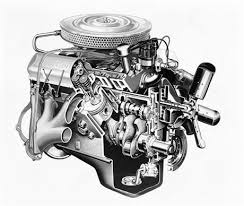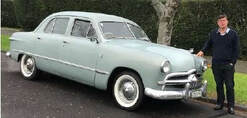 Today when one looks at an American car, we think of the lovely sound it makes due to its overhead valve V8 engine. This was not always the case though. For example in 1950 each major maker of cars offered a different type of engine, but within 5 years all car makers were offering an overhead valve V8. These became the engine of choice for the car buying American public. Why did this happen? Let’s go back to 1950. The two largest selling cars of that year were Ford and Chevrolet. Ford offered its venerable flat head V8, and although 6 cylinders engines were offered the eights were the most popular. Mercury and Lincoln offered just one engine type, the flat head V8. Chevrolet offered one type of engine, its well established overhead valve straight six. Plymouth, Dodge and DeSoto all offered flat head straight six motors, but Pontiac and Chrysler were different offering a straight eight flat head motor on their luxury models, and Buick had an overhead valve straight eight motor. The major car producers that stood out in 1950 were Oldsmobile and Cadillac, who both used an overhead valve V8. Yet within five years the ever popular flat head V8’s were history, and straight 8’s, whether flat heads or overhead valves were gone. Plymouth and Dodge continued to offer flat head 6’s, but these were in their final days, and the vast majority of their buyers were now opting for the OHV V8 models. What caused the major shift to this new type of engine? 1) The big horsepower race had begun. For example in 1950 a Ford V8 produced 100 bhp, but by 1955 this had increased to 162bhp, and other makers follow also. Overhead valve V8 engines were easier to adapt to this rising horse power race, due to changing carburettors, compression ratios, head design and engine capacity. 2) Interstate freeways were being developed and completed, which meant motorists were able to travel a lot further and faster. To make this more pleasant and to be able to overtake an increasing number of vehicles on the road, vehicles need to be able to travel faster, hence they needed more horse power. Cars became larger. The average family at this time had around four children, pets were popular, hence the demand for larger roomier cars continued. 3) The overhead powered V8 not only gained a reputation for increasing power but it was also proving to be reliable. Fuel economy was not really an issue in the 1950’s but it was soon apparent that the ever increasing powerful V8s were actually relatively fuel efficient and more much powerful, especially when compared to some of the older straight 8 motors. 4) The V8 is a compact engine. It takes up less room under a bonnet when compared to straight 6’s, and most certainly when compared to a straight 8. 5) Incomes were rising throughout the 1950’s and unemployment was at record lows. As a result, this increased the demand for cars. Hire purchase started to come into it own and it was much easier to purchase a car on time payment than just a decade previously. The two car family also started to develop in the 1950’s which further created the demand for cars. 6) Increase in suburban living. People were leaving the older type of apartments in the inner city and moving out to houses, with land and white picket fences in the suburbs. The term “commuter belt” developed. In order to live in the suburbs and commute to your place of work, often in the city centre, you needed a car. The cars had to be reliable and comfortable. This was further accentuated in the USA, as well as countries like Australia and New Zealand, which had under developed or virtually non-existent public transport systems. The car was the king. This massive switch to the overhead valve V8 engine which occurred in the 1950’s is still around with us. Most of us who own American cars will agree that the engine type and sound is one of the major reasons that attracts us to our American cars today. William Cairns Owner of a 1949 Ford Single Spinner with a flat head V8
1 Comment
Rob Milligan
17/8/2020 08:20:01 am
Great article William, much appreciated :-)
Reply
Leave a Reply. |
Categories
All
Archives
July 2024
|
